In the figure below, battery is connected across capacitors of capacitance and . What are (a) the equivalent capacitance of the capacitors and (b) the charge stored by What are (c) and (d) of capacitor (e) and (f) of capacitor and (g) and (h) of capacitor ?
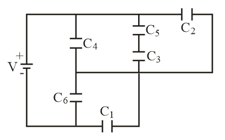


Important Questions on Capacitance
Figure represents two air-filled cylindrical capacitors connected in series across a battery with potential Capacitor has an inner plate radius of an outer plate radius of and a length of . Capacitor has an inner plate radius of an outer plate radius of and a length of The outer plate of capacitor is a conducting organic membrane that can be stretched, and the capacitor can be inflated to increase the plate separation. If the outer plate radius is increased to by inflation, (a) how many electrons move through point and (b) do they move toward or away from the battery?
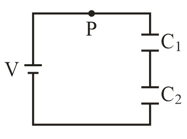
For the arrangement of figure, given below, suppose that the battery remains connected while the dielectric slab is being introduced. Calculate (a) the capacitance, (b) the charge on the capacitor plates, (c) the electric field in the gap, and (d) the electric field in the slab, after the slab is in place.
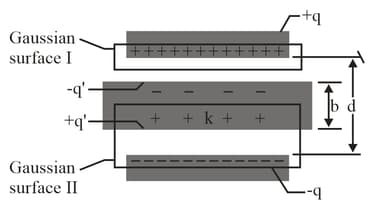
Assume , , , , and .
In the following figure, the capacitance are and and both capacitors are charged to a potential difference of but with opposite polarity as shown. Switches and are now closed. (a) What is now the potential difference between points and ?

Capacitor in Fig. (a) is a variable capacitor (its capacitance can be varied). Figure (b) gives the electric potential across capacitor versus The horizontal scale is set by Electric potential approaches an asymptote of as What are (a) the electric potential across the battery, (b) and (c)
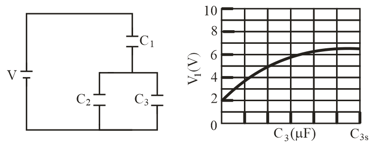
(a) (b)
The capacitors in Fig. are initially uncharged. The capacitance are and , and the battery's potential difference is When switch is closed, how many electrons travel through (a) point (b) point ,(c) point and (d) point In the figure, do the electrons travel up or down through (e) point and (f) point ?
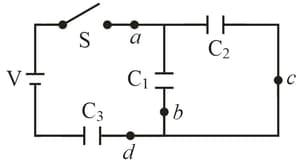
The figure shows a circuit section of four air-filled capacitors that is connected to a larger circuit. The graph below the section shows the electric potential as a function of position along the lower part of the section, through capacitor . Similarly, the graph above the section shows the electric potential as a function of position along the upper part of the section, through capacitors and . Capacitor has a capacitance of . What are the capacitance of (a) capacitor and (b) capacitor
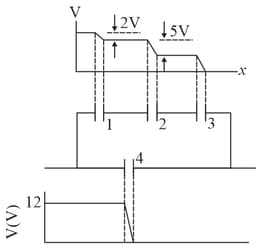
A charged isolated metal sphere of diameter has a potential of relative to at infinity.
(a) Calculate the energy density in the electric field near the surface of the sphere.
(b) If the diameter is decreased, does the energy density near the surface increase, decrease or remain the same?
